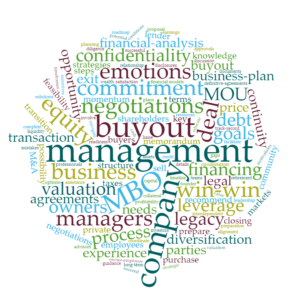 Sitting down and writing quality articles on business valuation, exit planning, mergers and acquisition strategy has taken a back seat this year, thanks to a strong M&A market. In this post I will recap many of the transactions for which Exit Strategies (ESGI) provided sell-side advisory services during the first half of 2019.
Sitting down and writing quality articles on business valuation, exit planning, mergers and acquisition strategy has taken a back seat this year, thanks to a strong M&A market. In this post I will recap many of the transactions for which Exit Strategies (ESGI) provided sell-side advisory services during the first half of 2019.
I haven’t included deals that we were asked not to announce. Nor have I included the internal buy-sell transactions, management buyouts and generational transfers for which ESGI provided an independent business valuation. As always, deal terms are not disclosed to respect the privacy of our clients.
Sale of Eldercare Services to Home Care Assistance
Eldercare Services is one of the San Francisco Bay Area’s top professional eldercare management and home care services providers. The baby boomer owners of ES were looking to turn their business investment into cash (i.e. “liquify” their investment), maximize value and retire. Home Care Assistance is a leading provider of home care for seniors in 150 regions throughout the United States, Canada, Puerto Rico and Australia. (service, health care)
Sale of DC Precision to Tecan Group
DC Precision, established in 1999, manufactures high precision plastic valve assemblies for life science OEMs and metal products for Silicon Valley high-tech manufacturers. Our client was ready to pursue other business interests. Tecan Group is a Swiss manufacturer of automated workflow equipment for pharmaceutical and biotechnology companies, university research departments and diagnostic laboratories. (contract manufacturing, CNC machining, proprietary technology, turn-key assembly)
Sale of Precision Asphere to II-VI Optical Systems
Precision Asphere produces aspherical optical components (lenses and mirrors) using proprietary surface-forming technology. The majority owner wanted to retire. II-VI Optical Systems develops and produces highly engineered materials and material systems for medical, defense, aerospace and military clients. (manufacturing, technology)
Sale of Axis of New England and New York to Motion Industries
Read the ESGI announcement here. Our clients were looking to take advantage of industry consolidation and maximize value through a competitive M&A sale process. (distribution, manufacturing, robotics, technology, service, system integration)
Sale of DZINE Living to Haworth
DZINE is an interior design services and contemporary European furnishings retailer in San Francisco. Our clients were looking to align with a major industry player that would help DZINE to expand its footprint. Haworth is a global company that designs and sells furniture, furniture systems, architectural products, textiles, wall surfaces, and ergonomic and technology tools for workspaces, education and health care. (retail, service)
Sale of You & Me Children’s Center to an Industry Investor
Founded in 1981, You & Me Children’s Center is a local preschool committed to providing a nurturing, safe and educational environment for children. The owner wanted to retire, liquefy her investment and see her legacy survive. The buyer is an experienced preschool operator. (service, education)
Sale of Home Tutoring Plus to a Private Investor
Home Tutoring Plus is a tutoring company serving schools and home school families throughout much of Northern California. Professional tutors provide individualized lessons, in-home and online. Our client engaged us to locate a buyer that would preserve her legacy while maximizing her investment so she could pursue new interests in retirement. (service, education)
Sale of Redwood Building Maintenance Company to Silicon Valley Building Services
Founded in 1965, Redwood Building Maintenance is a full service janitorial and building maintenance company serving the North San Francisco Bay Area. The family owners were ready to retire. Silicon Valley Building Services primarily serves the south and east Bay Area and this gave them an opportunity to expand. (B2B services, contract maintenance)
Sale of Banner Enterprises to Valley Comfort
Banner Enterprises and Valley Comfort Heating and Air are both full service commercial HVAC companies serving the Bay Area. Our client was looking to sell his business and building in order to retire and reinvest. (construction, services, real estate)
Sale of Communique Interpreting to DCARA
Since 1994, Communique Interpreting has provided in-person sign language interpreting services from Monterey to the Oregon border, in medical, employment, education, legal, performing art and social services settings. Our client wanted to sell her business and building and retire. DCARA, a 501(c)3 charitable organization, provides interpreting, advocacy and employment services for hearing impaired children, adults and families in Northern California. (services, non-profit, commercial real estate)
Sale of a Dietary Supplements Producer to a Strategic Buyer
A producer of herbal supplements sold through U.S. medical practitioners. The owner engaged us to find a strategic partner that could scale the company and allow him to reduce his involvement in operations and transition to retirement. (health care, manufacturing)
Market Observations
Two themes jump out at me: most acquirers were strategic and most sellers were looking to retire. Indeed, we’re seeing tremendous strategic acquisition activity in most industries. Most sellers are well positioned to maximize value through a structured auction (competitive bid) process run by a professional M&A brokerage firm like ours. As long as baby boomers continue to age out, Exit Strategies will be here to facilitate their retirements.
Action Items
If you are considering exiting your company for any reason, call or Email us to discuss your goals and circumstances, and how you can leverage Exit Strategies’ process, resources and experience to improve your results. If you are waiting for market conditions to improve, stop waiting and start the process!
Al Statz is founder and President of business valuation and M&A brokerage firm Exit Strategies Group, Inc., which has offices in California and Oregon. For further information or to discuss a valuation or M&A question or need, confidentially, you can reach Al at 707-781-8580 or alstatz@exitstrategiesgroup.com.
 Cashing in on the sale of your business is the final reward for many years of dedication and hard work. Then your CPA tells you how much you will owe in taxes. It’s a shock, but there’s a relatively new reinvestment opportunity that may help trim your tax bill …
Cashing in on the sale of your business is the final reward for many years of dedication and hard work. Then your CPA tells you how much you will owe in taxes. It’s a shock, but there’s a relatively new reinvestment opportunity that may help trim your tax bill …
 Assembly Bill 5 (AB5), signed into law last month by governor Gavin Newsom, will impact the valuation of many small businesses in California that have grown to depend on independent contractors. For impacted owners intending to sell in the near term, this new law may require a change of plan.
Assembly Bill 5 (AB5), signed into law last month by governor Gavin Newsom, will impact the valuation of many small businesses in California that have grown to depend on independent contractors. For impacted owners intending to sell in the near term, this new law may require a change of plan.

 The sale of a business includes intangible assets. This article explains what intangible assets are and how articulating, supporting and protecting them enhances business sale outcomes. Let’s get started.
The sale of a business includes intangible assets. This article explains what intangible assets are and how articulating, supporting and protecting them enhances business sale outcomes. Let’s get started. A Phase I environmental site assessment is commonly required by buyers and lenders in merger and acquisition transactions that include commercial real estate. One may even be called for when the target company (seller) uses or stores hazardous materials at a leased facility.
A Phase I environmental site assessment is commonly required by buyers and lenders in merger and acquisition transactions that include commercial real estate. One may even be called for when the target company (seller) uses or stores hazardous materials at a leased facility. Sitting down and writing quality articles on business valuation, exit planning, mergers and acquisition strategy has taken a back seat this year, thanks to a strong M&A market. In this post I will recap many of the transactions for which Exit Strategies (ESGI) provided sell-side advisory services during the first half of 2019.
Sitting down and writing quality articles on business valuation, exit planning, mergers and acquisition strategy has taken a back seat this year, thanks to a strong M&A market. In this post I will recap many of the transactions for which Exit Strategies (ESGI) provided sell-side advisory services during the first half of 2019. Many sellers worry that employees might “hit the panic button” when they learn that a business is up for sale. Yet, in a recent article from mergers and acquisitions specialist Barbara Taylor entitled, “Selling Your Business? 3 Reasons Why Your Employees Will Be Thrilled,” Taylor brings up some thought-provoking points on why employees might actually be glad to hear this news. Let’s take a closer look at the three reasons that Taylor believes employees might actually be pretty excited by the prospect of a sale.
Many sellers worry that employees might “hit the panic button” when they learn that a business is up for sale. Yet, in a recent article from mergers and acquisitions specialist Barbara Taylor entitled, “Selling Your Business? 3 Reasons Why Your Employees Will Be Thrilled,” Taylor brings up some thought-provoking points on why employees might actually be glad to hear this news. Let’s take a closer look at the three reasons that Taylor believes employees might actually be pretty excited by the prospect of a sale. Business owners who choose the MBO
Business owners who choose the MBO  Unfortunately, the probable selling price fell slightly short of what the client needed to retire (after taxes). We identified excessive inventory as one of the factors that was limiting enterprise value. How did inventory reduce value and spoil our client’s exit strategy? What can they do resolve this limitation? Read on for the full story.
Unfortunately, the probable selling price fell slightly short of what the client needed to retire (after taxes). We identified excessive inventory as one of the factors that was limiting enterprise value. How did inventory reduce value and spoil our client’s exit strategy? What can they do resolve this limitation? Read on for the full story.

